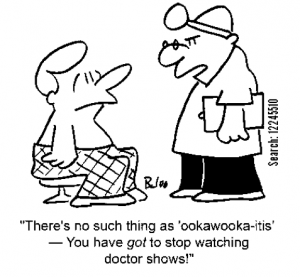“There are no dumb questions.” We’ve all heard this before, and as a result, we ask questions for all sorts of reasons. We ask questions because we want to know the answer or because we want to prompt someone else to get to the answer. We ask questions to impress our professors or classmates, to stand alone rhetorically, and to fill awkward silences. We ask questions constantly to other people, to anyone who’s listening, and even to ourselves (don’t pretend you don’t talk to yourself too).
So, why is it that we suddenly clam up in front of our doctors?
Many patients suffer from “white-coat silence,” or “a reluctance to vocalize questions to physicians.” At first this might sound ridiculous. Isn’t that your doctor’s job? To be the medical expert who answers your questions? Why wouldn’t you talk to him/her? While for many people this might seem obvious, for others, the doctor’s office is a strange, scary place where it’s a lot safer to just listen and let the doctor tell you what to do.
However, communication is key to successful patient-doctor interactions. In fact, a study found that the most powerful predictor of positive physician communication is good patient communication, which—surprise, surprise—includes the tendency of patients to ask questions. By asking a question, patients catalyze a cycle of patient-doctor communication in which they provide an opportunity for physicians to share information and give support. Not only does this increase a patient’s knowledge about their own health, but it also makes them feel more comfortable in the clinical setting, making for a better patient-doctor relationship.
So, why don’t patients talk to their doctors?
Intimidation, anxiety, and even impatience are just a few reasons. However, a study published in 2007 found that low health literacy is one of the most influential factors negatively affecting patient communication. Patients with low health literacy ask fewer questions, are less likely to use medical terminology, and ask less meaningful questions (e.g. “What is the name of that medicine?” rather than “Will I be in danger if I increase my dosage?”). Conversations with your doctor are much less beneficial if you don’t know what to say. With such a short amount of time per visit, low-literacy results in missed opportunities for patients to become more engaged and informed about their own health during their doctor’s appointment. Sometimes, patients who are aware of their low health literacy are too embarrassed to ask questions at all.
So, how is this being addressed?
The Agency for Healthcare Research and Quality (AHRQ) released a toolkit for improving health literacy. One of the guidelines was to “Encourage Questions.” Patients with low health literacy can benefit more from their visits if they know what questions to ask. By empowering these patients to see the benefits of speaking up, they can slowly learn that there are no dumb questions and learn to effectively communicate with their doctors. Over time, this increased communication can lead to the gathering of more health information, improved health literacy, better communication, and ultimately better health outcomes.
So, what can we do about this?
AHRQ also published a question guide that can be utilized by all patients, as everyone can stand to benefit from communicating with their doctor. Any MMAL group involved in patient-doctor interactions should keep patient-initiated solutions as an important consideration. Patient involvement indicates to the doctor that the patient is interested and engaged in their own health. It also helps battle the ‘intimidation’ factor in white-coat silence by empowering patients and giving them some authority. In developing our media solutions, the ‘not-dumb’ question we should ask is “How will this help catalyze patient-doctor communication?” because active patients make for happy doctors, which leads to better patient care.
Judson, T. J., Detsky, A. S., & Press, M. J. (2013). Encouraging patients to ask questions: How to overcome “white-coat silence”. Journal of the American Medical Association, 309(22), 2325–2326
Street RL Jr, Gordon H, Haidet P. Physicians’ communication and perceptions of patients: Is it how they look, how they talk, or is it just the doctor? Soc Sci Med. 2007;65 (3):586–598.
Katz MG , Jacobson TA , Veledar E , Kripalani S . Patient literacy and question-asking behavior during the medical encounter: a mixed-methods analysis . J Gen Intern Med . 2007 Jun;22(6):782–786 Epub 2007 Apr 12.


